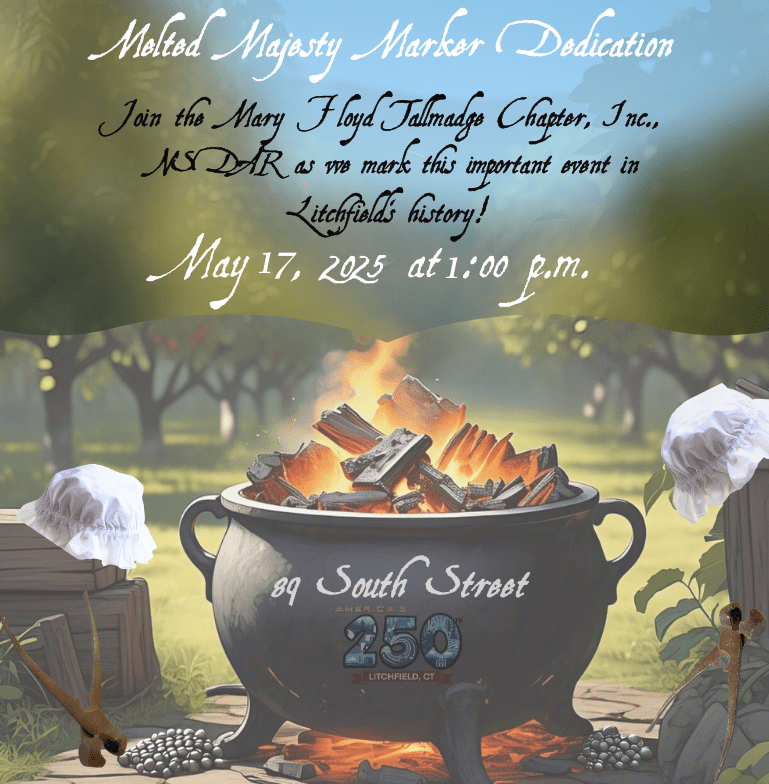South St. Marker Honors Melting George III for Musket Balls
 Oliver Wolcott Sr. (1726-1797) was a major figure in the American Revolution. He signed the Declaration of Independence, served as a major general in the Connecticut militia, was a member of the Continental Congress, and became the 19th Governor of Connecticut. He died while in office in 1797 and is buried in East Cemetery on East Street (Route 118) in Litchfield.
Oliver Wolcott Sr. (1726-1797) was a major figure in the American Revolution. He signed the Declaration of Independence, served as a major general in the Connecticut militia, was a member of the Continental Congress, and became the 19th Governor of Connecticut. He died while in office in 1797 and is buried in East Cemetery on East Street (Route 118) in Litchfield.
One of Litchfield’s most intriguing pieces of Revolutionary War trivia – apart from George Washington’s spymaster Benjamin Tallmadge coming to Litchfield and living on North Street after the war – happened in Wolcott Sr.’s backyard on South Street.
It was there, as the story goes, that Wolcott Sr., his wife, Laura, and their children were joined by other patriots in melting pieces of the statue of King George III that had stood in Bowling Green in New York City until it was toppled by the Sons of Freedom on July 9, 1776, who were inspired by a reading of the Declaration of Independence.
The Wolcott family and compatriots melted George to cast musket balls for Revolutionary War soldiers, and 42,088 in all were produced in Litchfield.
Now, thanks to the Mary Floyd Tallmadge Chapter of the National Society of the Daughters of the American Revolution, a marker is being placed in front of the Oliver Wolcott, Sr. house at 89 South Street to commemorate one of Litchfield’s notable contributions to the war effort.
A ceremony unveiling the marker will be held at 1 p.m. May 17, and the public is invited to attend. While RSVPs not required, they’re helpful and those planning to come can say so here.
The arrival of the marker comes at a time when a committee of the Litchfield Patriots., Inc. is coordinating efforts for the celebration of the 250th anniversary of the signing of the Declaration of Independence in 2026, called the Semiquincentennial. Follow the America’s 250th in Litchfield website and Facebook page for updates.
The Revolutionary War Fervor in Litchfield
Meanwhile, The Ledger published by the Litchfield Historical Society, provides context for Litchfield’s role during the Revolutionary War:
As the imperial crisis unfolded, a large majority of the town’s residents joined the ranks of protest and rebellion. Patriot activity in the county, from outcries against the Stamp Act in 1765 to the 1774 resolutions of solidarity with beleaguered Boston, originated in Litchfield. Although they were located away from the fighting, the townspeople found ways to support the American cause. Its distance from the coast offered the town some protection from the British, yet Litchfield’s network of roads connected it with both New England and New York. Townspeople stored military supplies for the American army, housed senior prisoners of war, and melted and molded the New York City statue of King George III into bullets for the American army. Local revolutionaries included Oliver Wolcott, signer of the Declaration of Independence and Major Moses Seymour, in whose home prisoner David Matthews was confined.
And a Connecticuthistory.org post entitled Litchfield’s Revolutionary War Soldiers’ Tree offered information on those from Litchfield who fought in the war:
In all, 507 men from Litchfield served the Patriot cause between 1775 and 1783. The first to serve were the men of the company led by David Welch of Milton, who were called up soon after news of Lexington and Concord arrived. A second company enlisted in January 1776 to serve for the defense of New York City. They drafted a contract specifying the terms of their service under Major General Charles Lee, stating that they were convinced of “the Necessity of a body of Forces to defend against certain Wicked Purposes formed by the instruments of Ministerial Tyranny.” …

